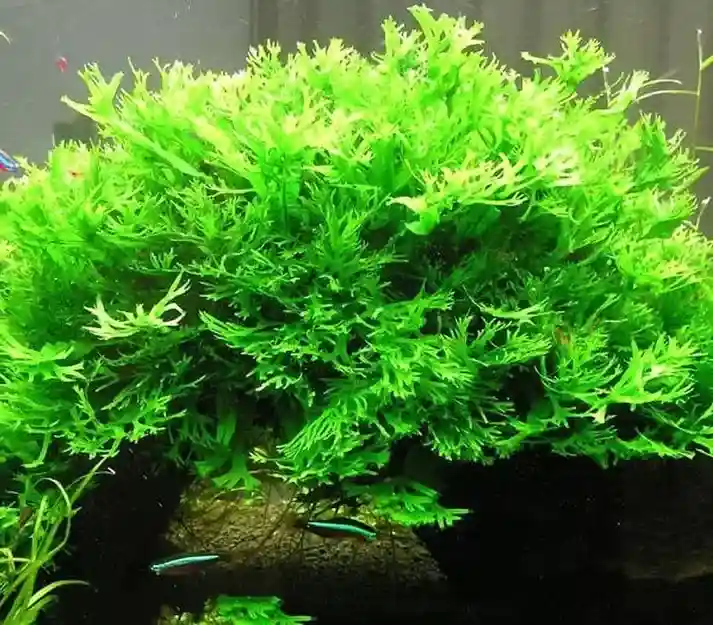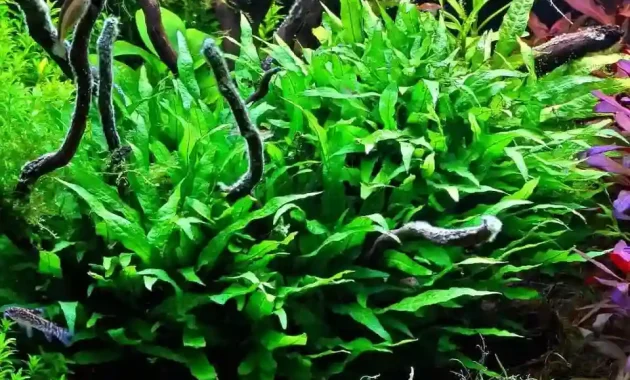Microsorum Pteropus ‘Windelov’ AKA Java fern windelov, a unique aquatic plant species, is gaining popularity among aquarists as it adds beauty and variety to aquariums of all sizes. This fern features long and narrow leaves with a distinctive zigzag pattern, adding a touch of elegance to any aquarium. The java fern windelov is one of the easiest plants to care for and can thrive in a wide range of aquarium conditions.
In this article, we will explore the specifics of java fern windelov care, propagation, and placement in your aquarium. We’ll also discuss ideal lighting and temperature conditions and nutrient requirements for this plant to thrive in your aquascape.
Key Takeaways:
- Java fern windelov is a popular aquatic plant species among aquarists due to its unique appearance and ease of care.
- This fern requires specific water parameters, lighting conditions, and nutrient levels to maintain healthy growth.
- You can propagate java fern windelov through division and spore reproduction.
- Java fern windelov can be showcased in a variety of aquascaping styles and aquarium layouts, adding a touch of elegance to your aquarium.
Understanding Java Fern Windelov Care
Java Fern Windelov is a hardy and low-maintenance aquarium plant that can flourish in a variety of conditions. However, to ensure optimal growth and health, it’s essential to provide adequate care. Here is a comprehensive guide to caring for Java Fern Windelov in your aquarium:
Water Parameters
Java Fern Windelov can thrive in a wide range of water parameters. However, it’s best to maintain a slightly acidic to neutral pH level between 6.0 and 7.5. The water hardness should be between 3-8 dKH, and the ideal temperature range is between 68°F and 82°F. Remember to perform regular water changes to maintain the water quality and prevent the buildup of harmful toxins.
Lighting
Java Fern Windelov does not require intense lighting and can grow well in low to moderate light conditions. However, to promote optimal growth and prevent algae, it’s recommended to provide at least 2 watts of light per gallon of water. Ensure to use a full-spectrum light that simulates natural sunlight and provides enough illumination for photosynthesis.
Nutrients
Java Fern Windelov can obtain nutrients through its rhizomes and leaves, but it’s important to supplement its growth with essential nutrients. You can add fertilizers to the water column or the substrate to provide macronutrients like nitrogen, phosphorus, and potassium, and micronutrients like iron, zinc, and manganese. Be careful not to over-fertilize, as it can lead to algae growth and harm the plant.
Substrate
Java Fern Windelov can grow well in different substrates, but it prefers a nutrient-rich substrate that can provide nourishment to its roots. You can use a combination of sand and gravel with a layer of peat moss or an aquatic soil mix. Avoid using substrates that contain high levels of carbonates, as they can raise the water pH and harm the plant.
Propagation
Java Fern Windelov is an easy-to-propagate plant that can be divided and replanted, or grown from spores. To divide the plant, gently separate the rhizomes and plant them in separate pots or attach them to rocks or driftwood with fishing line or glue. To grow from spores, collect the spores and sow them in a suitable environment with ideal lighting, temperature, and humidity.
Caring for Java Fern Windelov is relatively easy, and with proper maintenance, it can enhance the beauty and health of your aquarium. Follow these care guidelines, and your Java Fern Windelov will thrive and become a stunning addition to your aquatic oasis.

Propagating Java Fern Windelov
If you want to grow a lush green aquarium with Java fern Windelov, propagating it can be one of the best ways to achieve this. This plant can be propagated through two methods: division and spore reproduction.
Division
Division is the most common method for propagating Java fern Windelov. This method involves cutting the rhizome of the plant and separating it into smaller portions, each containing several leaves.
The best time to perform division is when the plant has grown enough that it starts producing new leaves from its rhizome. The process is simple and can be done by carefully cutting through the rhizome using a sharp and sterile tool. Make sure each portion has enough leaves and roots to grow independently.
After separating the portions, plant them in their own sections of the aquarium. Ensure that the environment conditions are suitable for the plant’s growth, including adequate lighting, temperature, and nutrition. During the initial phase, do not disturb the newly planted portions as the roots will be sensitive to any disruption.
Spore Reproduction
The second method for propagating Java fern Windelov is spore reproduction. This method is more challenging than division and requires a lot more patience. Spores are produced on the underside of mature Java fern Windelov leaves.
The spores need to be collected and placed in a suitable environment for germination. You can use a small container and add a layer of substrate before spreading the spores on it. Cover the container with cling wrap to keep the humidity high. Keep the container in a warm and shaded area while the spores germinate and start producing tiny plants.
The process can take several weeks or even months to complete, and only a tiny percentage of spores will germinate. Once the tiny plants have grown enough, they can be planted in the aquarium substrate.
Propagation of Java fern Windelov is a rewarding process that requires patience and attention to detail, resulting in a beautiful and healthy aquarium.
Showcasing Java Fern Windelov in Your Aquarium
Java fern windelov is a versatile and visually appealing plant that can enhance the beauty of any aquarium. When selecting tank mates for your java fern windelov, it’s essential to consider compatibility to ensure a harmonious coexistence. Good candidates include peaceful fish like tetras, guppies, and shrimp species such as cherry shrimp and amano shrimp. Avoid aggressive or territorial fish that may nip at the plant, such as cichlids or bettas.
The placement of java fern windelov in your aquarium is critical to maximizing its visual impact. This plant’s flowing leaves and distinctive shape make it an ideal choice for creating eye-catching focal points or lush background displays. Try placing it towards the center or rear of the tank to create depth and dimension. If you prefer a more naturalistic look, consider combining java fern windelov with other aquatic plants such as anubias or mosses.
When incorporating java fern windelov into your aquascape, be creative and experiment with various placement options to find the perfect arrangement for your aquarium. Consider grouping multiple plants together for a dramatic effect or planting them in different locations to create a more natural feel. The possibilities are endless with this versatile and stunning plant.
Meeting Lighting Requirements for Java Fern Windelov
Java Fern Windelov is a low light plant that does not require intense lighting. However, it still needs a moderate amount of light to grow and thrive. The ideal light intensity for Java Fern Windelov is between 2 to 3 watts per gallon. The duration of light exposure should be 8 to 10 hours per day.
It is important to note that excessive light exposure may lead to algae infestation. Therefore, it is recommended to use a timer to regulate the light exposure duration. Additionally, providing a shaded area in the aquarium can help prevent the plant from receiving too much light.
To meet the lighting requirements for Java Fern Windelov, it is recommended to use LED lights. LED lights provide the ideal balance of light intensity and duration while being energy efficient and long-lasting. They also offer a range of color temperatures that can enhance the visual appeal of your aquarium.
Creating the Ideal Temperature for Java Fern Windelov
Java fern windelov is a versatile aquatic plant that can thrive in a range of temperature conditions. Nevertheless, providing the ideal temperature can significantly enhance its growth and appearance.
The preferred temperature range for java fern windelov is between 68 to 82 degrees Fahrenheit. The plant is tolerant of temperature fluctuations and can survive in temperatures as low as 60 degrees Fahrenheit and as high as 86 degrees Fahrenheit.
It is essential to monitor the temperature in your aquarium carefully. Sudden temperature changes can adversely affect the plant’s growth and make it susceptible to diseases. Use a reliable thermometer to check the water temperature regularly and make adjustments if necessary.
Installing a heater in your aquarium can help maintain a consistent temperature and prevent fluctuations. Choose a heater that is appropriate for your tank size and can provide the desired temperature range. Position the heater near the water flow to ensure even distribution of heat.
Nutrient Requirements for Java Fern Windelov
Java fern windelov is a hardy plant that can thrive in a variety of aquarium conditions, but proper nutrient supplementation is essential for optimum growth and health. To maintain long-term success with this plant, it’s important to understand its specific nutrient requirements and how to provide them.
Macronutrients
Macronutrients are the primary elements that plants require in relatively large quantities for healthy growth. In the case of java fern windelov, the most critical macronutrients are:
- Nitrogen (N): Essential for chlorophyll production and overall plant growth. Nitrogen can be supplied through fertilizers or through fish waste and decomposing organic matter in the substrate.
- Phosphorous (P): Required for energy transfer and cell division. Phosphorous can be provided through fertilizers, but excess amounts can promote algae growth.
- Potassium (K): Plays a vital role in regulating water balance, enzyme activation, and carbohydrate production. Potassium can be supplied through fertilizers and fish waste.
Micronutrients
Micronutrients are elements that plants require in smaller quantities. The most important micronutrients for java fern windelov are:
- Iron (Fe): Essential for chlorophyll synthesis and energy production. Iron can be supplied through root tabs or liquid fertilizers.
- Manganese (Mn) and Magnesium (Mg): Required for enzyme activation and photosynthesis. These can be provided through liquid fertilizers.
Common Nutrient Deficiencies
Even with proper nutrient supplementation, java fern windelov can still experience deficiencies and related symptoms. The most common deficiencies include:
- Iron deficiency: Yellowing of leaves and reduced growth. This can be remedied by adding iron-rich fertilizers or root tabs.
- Potassium deficiency: Yellowing and curling of leaves, stunted growth. Potassium can be supplemented through fertilizers and fish waste.
- Nitrogen deficiency: Stunted growth, pale leaves. Nitrogen can be supplemented through fertilizers or through decomposing organic matter in the substrate.
By understanding the essential nutrient requirements of java fern windelov, aquarists can ensure this beautiful plant thrives in their aquarium and enhances the overall aesthetic appeal of their aquascape.


